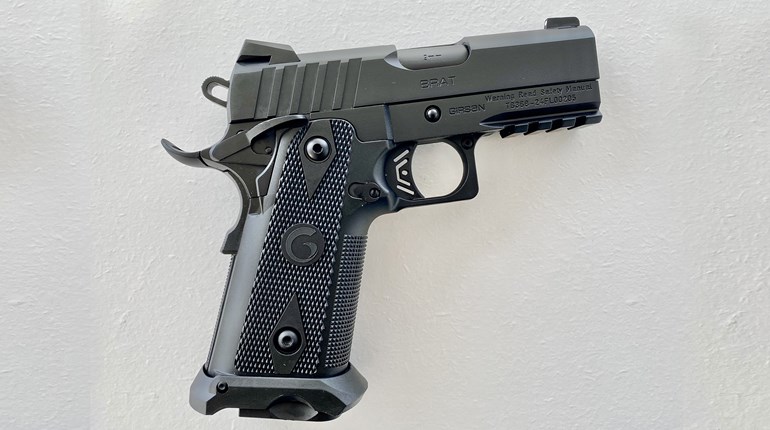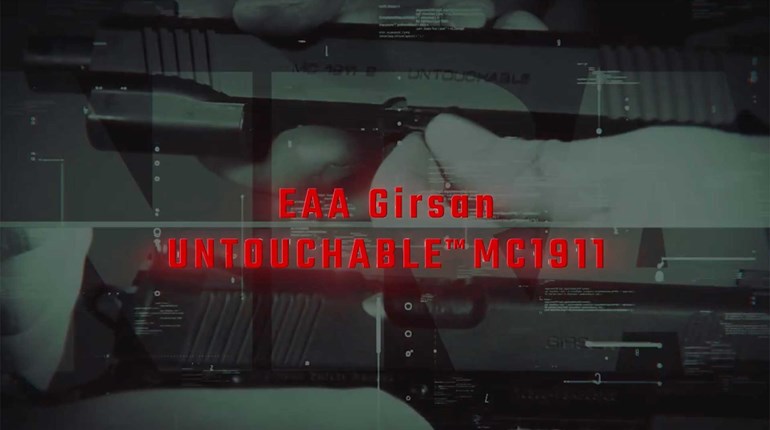
Since the previous installment ended with removing the slide, I decided to begin this portion of complete disassembly by focusing on the slide. Even though none of the modifications I wish to do on my pistol regarding any slide internals, knowledge of how to remove, install and/or replace such internals is important should you encounter a broken firing pin or a weak firing-pin and/or extractor spring. This information would also be pertinent should the claw portion of your extractor break, become chipped or if the firing-pin safety (also known as the sear lever) ever become sluggish or weakened.
We’ll begin by removing the firing pin, firing-pin spring and firing-pin stop (also known as the firing-pin-retaining plate).
Placing the slide upside down on the workbench, take a small screwdriver and push the firing-pin safety (also known as the sear lever) down on the forward end, which lifts the safety from within the firing-pin channel allowing the firing pin to move freely. (Stephen Camp’s book suggests you can, “Fold a match-book cover, or thin piece of plastic and wedge it into the [slide’s] sear-lever’s channel. It will hold the lever in the depressed position and free up your hand to make removing the firing pin easier.”
With your other hand, take the shank of the slide-release lever or a punch that will pass through the firing-pin stop and depress the firing pin while simultaneously applying upward pressure on the firing-pin stop. This will cause the part (firing-pin stop) to slide out. The firing pin and its spring can now be shaken out onto the workbench and set aside, but the sear lever must be depressed to remove the firing pin and its spring on various Hi Power models such as later MK IIs and most MK IIIs in which the sear lever serves as a firing-pin block. Note: On such models, once the firing-pin stop is removed the firing pin and its spring are will still be under tension at this point and depressing the firing-pin safety/sear lever will send them flying. So, you may wish to place the back of your slide (firing-pin channel down) against the top of your workbench to contain the firing pin and its spring before depressing the firing pin safety/sear lever.
Once the firing-pin stop, the firing pin and its spring is removed, it’s time to remove the firing-pin safety/sear lever. To do so, place the slide, right side up on top a Brownells pistol bench block, or a Real Avid Smart Universal Bench Block, which offers the added benefit of being magnetized to grab and hold pins. (As an alternative, you could use a standard 2-inch diameter roll of packing tape.) Next, tear off a small piece of packing tape and poke a small hole in the center of it. (The roll pin the is hidden along the rear slide serrations.) Place the tape over the pin centering the pin in the hole so the pin is visible through the tape. This will safeguard your slide’s finish from marring.
Now, from right to left, using a 3/32-inch roll-pin punch from either the Cylinder & Slide BHP Armorer’s Punch Set or the BH Spring Solutions Deluxe Version MasterTools Components, drive out the roll pin. Don’t drive the pin out completely, just enough to lift the sear level and its spring out and set them aside. The bench block/packing-tape roll will keep the pin safely corralled and off the floor should you errantly drive it all the way out. Before going any further, I suggest storing the sear lever and its pin (in case you drove it all the way out) in a plastic bag to not only avoid unnecessarily losing any essential fiddly-bits, but also to keep from confusing the pins and other slide-related springs.
With the sear lever removed and separated/secured, you can remove the extractor and extractor spring and bag them separately. The next component to remove is the extractor and its spring. This time, tear another piece of packing tape, poke another hole in the center of it and place it over the roll pin located on the top of the slide so the pin is visible through the hole in the tape. Add a second, small piece of tape over the extractor to retain it in place once the roll pin is removed, to avoid holding the part in place as the pin is driven out. Now, with the slide centered and top side up on your bench block or tape roll and using a 5/64-inch roll-pin punch from either of the aforementioned tool sets, carefully drive the extractor’s roll pin downward—just far enough to free the extractor and its spring. Peel back the second piece of tape that keeps the parts secure while under tension, lift them out of the slide. Secure them in another plastic bag and set them aside. The slide is now completely apart.
Reassemble in reverse order, taking care not to force anything. If the parts are installed correctly, the slide components will go back together smoothly and little to no force will be required.
In order to completely disassemble the fieldstripped frame, it needs to be stated up front that a large portion of the process requires the hammer to be held in the rearward (or cocked) position while removing other frame components, which can be quite cumbersome, frustrating and tedious. Fortunately, for those who don’t wish to go the traditional route of disassembly, BHSpringSolutions offers a tool to make the process loads easier. It is appropriately named the “Third Hand Tool.” This video details how it works and what makes it such an invaluable tool for Hi Power tinkers.
However, for those who prefer old-school frame disassembly, start by removing the grips. The screwdriver that’s included in the Cylinder & Slide Armorer’s Punch Set is superb for the task. Next, remove the magazine release. The removal process is identical to that of the 1911 and, to my knowledge, it is the only internal design commonality the two pistols share.
To accomplish this, you will need a screwdriver that will fit the slotted screw on the right side of the pistol, opposite of the portion of magazine release that you actuate with your thumb. To remove the magazine release, place the frame on its left side onto either a bench block or your workbench and press downward of the frame to partially actuate the magazine release, which will cause the magazine release to protrude from the right side of the frame. This downward pressure on the frame until approximately half of the magazine release extends proud from the frame. While maintaining the pressure, insert your screwdriver into the slotted screw and turn counterclockwise. When the screw turns freely, rotate it as far as it will go, push the magazine out of the frame and set it aside.
Note: If your pistol has an ambidextrous safety, now is a good time to remove the right-side lever, which is attached to the shaft in place by a roll pin. To remove it, the pin must be driven out enough to permit the removal of the thumb-safety lever. Be aware, the roll pin is tapered, so the best way to remove it is from the bottom upward using a 1/16-inch roll-pin punch. Once removed, set the lever aside. Now, you’ll be able to finish disassembling the frame.
Then, remove the sear pin—the small pin, located near the sear—using a 3/32 punch. (It’s not tapered, so it can be removed from either direction.) When doing so, be sure to hold the hammer rearward and do not release it. Note: Once the punch is removed, the sear will pop out. Doing so will cause the top of the flat sear spring to go forward into the magazine well.
Then, while still keeping the hammer rearward, lift the bottom of the sear spring from the notch that secures it to the bottom portion of the frame. Once the sear spring is removed, then ease the hammer forward. (See why it’s so much easier to use BHSS’ Third Hand Tool now, don’t you?)
Rotate the ejector downward 90 degrees. There’s a slot cut in it and a “nub” located on the thumb-safety shaft must pass through it to remove it from the frame.
Once the ejector is rotated down, wiggle the thumb safety while lifting upward. When the two parts are lined up correctly, the thumb safety (along with its detent and spring—which will be compressed and under tension—will come out and it and the ejector can be removed and set aside.
With the thumb safety out, the hammer-strut/mainspring assembly can be lifted from the frame and set aside. At this point, you’re two thirds home, dear reader. All that remains is the most challenging part to remove: the trigger and its integral trigger pawl assembly. (By way, while the two parts are removed as a single unit, when it comes time to reassemble your Hi Power, the trigger pawl is inserted separately.) While it is true that the only thing holding it in place is the frame-mounted trigger pin—it cannot be understated just how challenging removing the trigger pin is. That’s because the trigger pin is press-fit into the frame at the factory, making it approximately 10 times more than what most people think of when the run-of-the-term “difficult” comes to mind. Removal of the trigger pin appears simple on the surface, but it requires a delicate balance of brute force, care, and above all, patience. I suggest covering the area of the frame around the trigger pin in the same packing tape I used to detail strip the slide. Place the frame, left side down, onto either a bench block or your workbench. Tear off a small piece of tape, poke a small hole in the center of it over the “pointed end” (not the flat end) of the frame’s trigger pin, centering the pin in the hole, so the pin is visible through the tape. This will safeguard your frame’s finish from marring.
Again, driving this pin out is going to be quite difficult. A wide, brass punch may be needed to “break the pin loose” from the frame. (The Cylinder & Slide BHP Armorer’s Punch Set contains one.) Two other “Specialty Punches” that are part of the BH Spring Solutions Deluxe Version MasterTools Components will become essential for removing this pin: specifically the 3/32 Non-Slip punch and the 3/32 Nail Punch. Begin the removal process by using the 3/32 Nail Punch. Once signs of movement are apparent, transition to the non-slip rubberized punch. Its concave point will cradle the pointed end of the trigger pin and help the removal process. Go slowly and steadily, and eventually the pin will eventually succumb to your persuasion.
Continue tapping on the punch until the grommet contacts the frame. Once it starts to move, switch to the Starter punch. It contains a rubber grommet that further aids in safeguarding the frame from unwanted damage. Once the pin is out, set it aside. You can now remove the trigger assembly by rotating the trigger down, rotating it forward and out of the frame through the trigger-guard area. During which, you may need to simultaneously depress the spring-loaded magazine-disconnect plunger, which is mounted to back of trigger via a corresponding pin. Given the type of Hi Power you have, there may be limited real estate inside the trigger guard, go slowly, allow gravity to your advantage and eventually the trigger will eventually the fall free.
To reassemble the pistol, simply reverse the process. (For anyone confused regarding any aspect of detail stripping the frame or slide, you can watch a detailed step-by-step animation of detailed stripping, here.
Both your frame and slide are completely stripped, providing you with the blank canvas needed to begin your Hi Power customization.
In the next entry I’ll detail the custom accessories I intend to swap and/or modify on the pistol, thereby making a good gun even better.



































